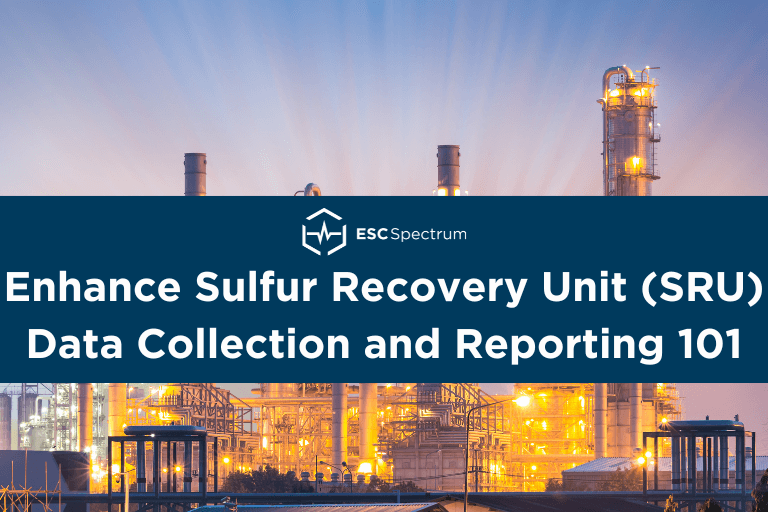Sulfur dioxide (SO₂) is a major pollutant emitted by oil refineries, with significant sources including catalytic or thermal cracking units, sulfur recovery units (SRUs), steam boilers, process furnaces, process heaters, and compressor engines. Thanks to advancements in technology and stricter regulations, SO₂ emissions in the United States have decreased by approximately 94% since 1970, reaching 1.7 million tons in 2023 (Statista).
SRUs play a critical role in managing and reducing these emissions in refineries and gas processing plants. Their efficiency in sulfur recovery is key to meeting stringent environmental standards, making SRUs an essential component of a refinery’s overall emissions control strategy.
Role of Sulfur Recovery Units
1. Sulfur Recovery:
SRUs are designed to recover sulfur from hydrogen sulfide (H₂S) gas produced during refining processes. In petroleum refining and natural gas processing, H₂S is a common byproduct, and if not treated, it can lead to harmful sulfur dioxide emissions.
2. Claus Process
Most SRUs use the Claus process, which converts H₂S into elemental sulfur. However, a portion of the H₂S typically remains as SO₂. Properly operating SRUs can recover around 95-98% of sulfur, reducing the amount of H₂S that oxidizes into SO₂ during combustion in tail gas treatment units. If necessary, a Tail Gas Cleanup Unit (TGCU) is required to recover the remainder (EPA).
3. Reduction of SO₂ Emissions
By maximizing sulfur recovery, SRUs reduce the release of SO₂ into the atmosphere, which is a significant pollutant contributing to acid rain and respiratory problems. Refineries must ensure the efficient operation of SRUs to comply with environmental regulations that limit SO₂ emissions.
4. Environmental Compliance
For compliance with regulations like those in 40 CFR Part 60, Subpart Ja, refineries must monitor and minimize SO₂ emissions. The performance of the SRU is directly tied to how much SO₂ is emitted. Continuous Emission Monitoring Systems (CEMS) are often used to track these emissions, with the data being integrated into a system such as StackVision for real-time monitoring and reporting.
Read how a Data Acquisition System like StackVision can improve efficiency at your facility.
How SRUs Work with StackVision for Accurate Emissions Monitoring
Alexis Ferguson, our Lead Senior System Implementation Engineer, discusses the details of integrating StackVision and SRUs:
The system collects data through various inputs, including analog signals, Modbus, or data historians like PI. From there, the Data Acquisition System (DAS), StackVision, manages the 1-hour data validation requirements under Part 60 and Part 63 by filtering out periods of maintenance, calibration, or analyzer/sampling system faults.
This ensures that only valid data is evaluated against permit limits or, if necessary, flagged as downtime.
One key feature of StackVision is its ability to automate daily calibrations and quarterly CGA (Cylinder Gas Audits), ensuring that calibration records are properly logged and flagged. The data controller also plays a big role by running daily calibrations and quarterly CGAs, recording calibration/CGA records, and flagging data appropriately during those times.
Additionally, StackVision automates report generation and sends CEMS alarms via email, reducing downtime and simplifying the reporting process for compliance teams.
SRU Data Management & Reporting with StackVision
SRUs are subject to compliance regulations under Part 60 Subpart J/Ja and Part 63 Subpart UUU, the latter of which closely mirrors the former. Depending on the site’s capacity, there are options for CEM systems, with most refineries opting for SO₂ and O₂ analyzers rather than Total Sulfur (TS) and H₂S analyzers. StackVision is installed to meet these regulatory requirements, ensuring compliance with the emission limits outlined in J/Ja, UUU, or any specific site permits.
Once installed, the system provides a comprehensive suite of reports that track emissions limits, downtime, calibration/CGA records, and other critical operational data. Additional features, such as calibration trends and bottle pressure tracking, help reduce the workload for technicians and improve overall efficiency at the site.
Addressing SRU Data Collection Pain Points
Refineries often struggle with 1-hour data collection and making it accessible to environmental teams, field technicians, and corporate leaders.
StackVision addresses these pain points by offering flexible solutions for integrating data into plant networks, making it easy for various teams to access the information they need.
StackVision’s customization options allow refineries to tailor the data collection and reporting process to suit the specific needs of each site, ensuring regulatory compliance while streamlining operations. Learn more today.
For a complete resource on emissions monitoring, explore our Comprehensive Emissions Monitoring Guide for Refining and Petrochemical Facilities, covering everything from best practices to regulatory compliance.

Taylor Hempel - Marketing Specialist II
Taylor Hempel is a skilled marketer specializing in content creation, social media management, and driving customer engagement. With a BBA in Marketing from the University of Texas at San Antonio, she joined ESC Spectrum in February 2022. Taylor is adept at crafting informative content about continuous emissions monitoring systems, its components and data acquisition systems allowing her to craft content that educates and informs industry professionals.


